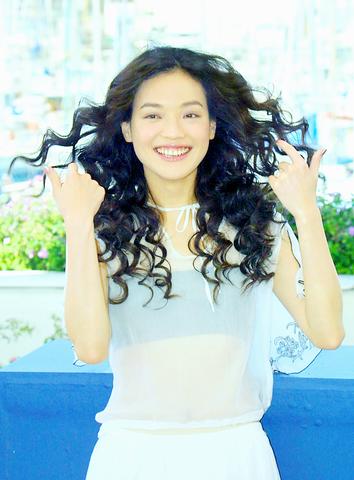"In real life, I could never be like the girl I played in the film," said Shu Qi (
"If I were Vicky, I would have squashed the guy and left long ago. And I would never have come back to the relationship," said the willful Shu.

PHOTO: AFP
Vicky's boyfriend Hao-hao (
As one of the most prolific and most expensive actresses in Hong Kong and Taiwan, Shu said she would jump at the chance to work again with Hou, regardless of the payment and the time needed for shooting. "This is the most challenging experience I've ever had and I've learnt a great deal from him," said the 25-year-old.
Wearing a slim, gray-colored Chinese dress, Shu charmed onlookers at Manray Beach in Cannes.
"At first it was hard for me to play this role because I don't identify with Vicky and her suffering in a relationship and the environment of drugs and hostess bars," Shu said.
To prepare for the role, Shu did extensive field work in dingy hostess bars with Hou and the film's crew. "Hou was very good at making me get used to the role." After a month of hanging out in bars and clubs, "I felt like Vicky had entered my body," she said.
"I cried for two hours before shooting one of the scenes. And I began to hate Tuan even off the set. I almost threw things at him in one scene because I was so furious," she said.
This is Shu's second trip to Cannes, the first being for Vivian Chang's (

Exceptions to the rule are sometimes revealing. For a brief few years, there was an emerging ideological split between the Democratic Progressive Party (DPP) and Chinese Nationalist Party (KMT) that appeared to be pushing the DPP in a direction that would be considered more liberal, and the KMT more conservative. In the previous column, “The KMT-DPP’s bureaucrat-led developmental state” (Dec. 11, page 12), we examined how Taiwan’s democratic system developed, and how both the two main parties largely accepted a similar consensus on how Taiwan should be run domestically and did not split along the left-right lines more familiar in

As I finally slid into the warm embrace of the hot, clifftop pool, it was a serene moment of reflection. The sound of the river reflected off the cave walls, the white of our camping lights reflected off the dark, shimmering surface of the water, and I reflected on how fortunate I was to be here. After all, the beautiful walk through narrow canyons that had brought us here had been inaccessible for five years — and will be again soon. The day had started at the Huisun Forest Area (惠蓀林場), at the end of Nantou County Route 80, north and east

Specialty sandwiches loaded with the contents of an entire charcuterie board, overflowing with sauces, creams and all manner of creative add-ons, is perhaps one of the biggest global food trends of this year. From London to New York, lines form down the block for mortadella, burrata, pistachio and more stuffed between slices of fresh sourdough, rye or focaccia. To try the trend in Taipei, Munchies Mafia is for sure the spot — could this be the best sandwich in town? Carlos from Spain and Sergio from Mexico opened this spot just seven months ago. The two met working in the

This month the government ordered a one-year block of Xiaohongshu (小紅書) or Rednote, a Chinese social media platform with more than 3 million users in Taiwan. The government pointed to widespread fraud activity on the platform, along with cybersecurity failures. Officials said that they had reached out to the company and asked it to change. However, they received no response. The pro-China parties, the Chinese Nationalist Party (KMT) and Taiwan People’s Party (TPP), immediately swung into action, denouncing the ban as an attack on free speech. This “free speech” claim was then echoed by the People’s Republic of China (PRC),